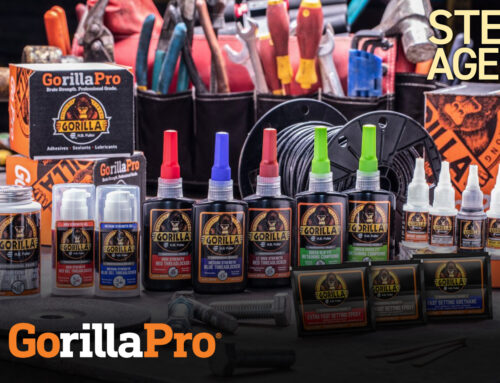Steeves Agencies has been supplying adhesives for almost 20 years now, and it’s been a great learning experience for us. Adhesives have been around for a long time, but only in the last 10-20 years have they been gaining acceptance in the manufacturing industry as a reliable means of bonding materials without using screws, nails or even welding!
Manufacturers Using Adhesives
Our adhesives customers are a diverse group. Most of our non-conventional users are manufacturers in the sheet metal world. They use adhesives in places where you can’t rivet or weld. Many of them are surprised by the versatility of adhesives, and once they try them, customers tend to look for other places to use them. There are some major cost savings to be found, you just need to re-imagine the way you do things now.
Types of Adhesives we carry
We offer a range of adhesives, each designed to meet specific needs:
Cyanoacrylate adhesives (often known as Krazy Glue or Super Glue) are fast-acting adhesives that cure quickly in most environments and are able to bond a wide range of materials permanently within minutes (or seconds). Cyanoacrylates have potential applications in many DIY projects, picture framing, household trim/molding installation, and there are even medical applications. There are a range of specialty-made cyanoacrylates for specialized applications and all of them come in a range of viscosities.
Methacrylate Adhesives create a strong bond that is durable even when faced with severe environmental conditions. Methacrylates (often called MMAs) are used in structural applications like boats, industrial trailer frames, or anywhere a long-lasting, extremely durable bond is required. MMA’s can, in some cases, be an alternative to welding.
Epoxies are an easy to use adhesive saving valuable production time and can be used when bonding glass, metal, and plastics, and can be a good alternative to welding, especially when bonding dissimilar metals. Epoxies are often used for “ruggedizing” electronics by encapsulating it in a hard, non-conductive material that can withstand intense vibration or impact.
UV Adhesives are extremely easy to use and cure in seconds when exposed to UV/visible light. UV Adhesives are often used in applications where the adhesive or the bonded area needs to be “invisible”. Dentists also use a version of a UV curing adhesive for invisible fillings!
Anaerobic Adhesives (thread lockers) are specifically engineered to cure in the absence of air and in the presence of metal ions. These anaerobic resins offer the best method to positively lock, retain, and seal a wide range of metal parts. Threadlockers are used to prevent bolts and machine screws from coming loose in high-vibration applications.
Adhesives Aren’t For Everyone
Adhesives are amazing materials but they aren’t perfect for certain applications. Certain types of plastics or UV gel coats on cars or boats, for example, don’t have ‘active’ surfaces and won’t allow proper adhesion to take place. These finishes are designed to be impervious to sunlight, grime, chemicals and abrasion and as such, aren’t suitable for adhesives. Similarly, some plastics are just not suited for bonding with adhesives. PVC pipe is a great example of this. PVC (Polyvinyl Chloride) has a really hard shell on it which can’t be bonded well with most adhesives. Mistakenly associated with being “glued” together, pipe adhesive isn’t an adhesive at all, it’s actually a solvent. PVC pipe isn’t glued together, it’s chemically welded. The solvent melts the PVC and once assembled, is welded together permanently.
Unexpected Applications
There are a number of ways in which adhesives can be superior to conventional methods of fastening:
- Adhesives provide some unique advantages over mechanical fasteners. For example, adhesives create a joint that is continuous and sealed without requiring any holes to be drilled, punched or laser cut. This provides a uniformly connected joint that is more rigid completely free of gaps.
- Adhesives are also very quick to apply. It takes only a few seconds to apply a bead of adhesive and a short time to cure.
- Adhesives also eliminate the risk of parts coming “unthreaded” in high vibration applications.
Client Success Story
Recently we heard a story from one of our ASI colleagues in the Southern US. His customer was a manufacturer of old-style porch screen doors made from wood. The best way to ensure the doors were assembled properly was to use wood glue and lots of clamps. The client was looking for ways to improve productivity (units per day) as they had enough demand, but they just couldn’t make it happen because the doors had to be clamped for 8 hours before being moved. In addition to the waiting time, some consideration had to be given to the number of clamps they would need in order to ramp up production. Keep in mind each clamp is worth about $150 each and they used 4 clamps per door. Another thing to consider was space. Where would they put these new doors even if they could make more?
What our colleague suggested was simply brilliant! He did some of his own testing and using a Cyanoacrylate (CA) and an Activator, he created a system that used the CA adhesive as a quick-tacking tool, while the major bonding was still done by the wood glue and a few fasteners. This process allowed them to assemble the door faster and move them safely to the next station because they didn’t need to be handled again.
By switching to this new technique, they doubled their production in a month! They eliminated the need for drying racks and freed up a lot of valuable floor space for finished products. They were even able to sell most of their clamps! The only thing that changed was the addition of the Cyanoacrylate and an Activator to their list of supplies and a little bit of training. It was a huge win for the client and a great story of how, with a little innovative thinking, manufacturers can improve productivity without changing much about the way they do business.
It was also a little mind-bending that adhesives can be used as a tool, not just as the final bonding agent. We don’t often think of using adhesives this way, so it makes for some interesting discussions, especially if it saves money on fixtures, tools, floor space, or production time.
Getting Started with Adhesives for Manufacturing
If you’re thinking of using adhesives in your manufacturing process, call us, email us, or drop in at our office so we can discuss your goals. We’re happy to provide samples, and help you test out different solutions to see what works best and what changes you might need to make.
We look forward to working with you!






